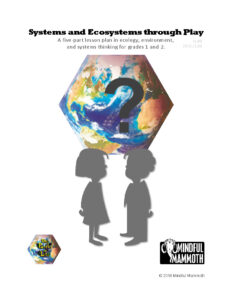
We've just published v1.00 of a thoughtful, detailed, and playful lesson plan aimed at students in first and second grade. It is now up on the web (
here), and freely available for use. The plan details a series of five short activities that will help students to learn about systems and ecosystems through play.
While the activities are based around the ideas in
The Puzzle of Life, only the first activity actually requires The Puzzle. Thus, if a classroom does not have access to the Puzzle, or does not wish to use the Puzzle, the latter four lessons in this lesson plan (which is most of it) will still serve as a great, free introduction to ecology and systems thinking.
The five hour-long activities go like this:
Day 1: Intro to The Puzzle of Life
Five minute intro lecture, explaining how the Puzzle uses arrows to model flows. Free Puzzle play. Free imaginative Puzzle piece construction.
Day 2: Intro to Systems
Mini-lecture on systems thinking. Tell of the story of wolves in Yellowstone, using the Puzzle of Life to illustrate. Color the Yellowstone Storybook.
Day 3: Begin Work on The Puzzle of Me
Introduce the idea of The Puzzle of Me. As a class, practice project tasks by creating a Puzzle around the life of the instructor or a famous person (ex: Katy Perry eats vegetables; vegetables come from farms; farms need water, sunlight, energy. Katy Perry creates music, joy, poop, etc.). Put students into working groups. As individuals, have students start work on the Puzzle of Me Project Workbook. Focus on the first page, where students map out their relationships / connections.
Day 4: Continue work on Puzzle of Me’s
Students continue working on their Puzzle of Me, with the help of instructor(s), and using the Project Workbook as scaffolding. Students should finish mapping their relationships early in the period, and spend most of the time creating Puzzle pieces based on the ideas described in their maps.
Day 5: Finish Puzzle of Me’s. Share student-made Puzzles. Reflect.
Students finish creating pieces for their Puzzle of Me. They probably won’t have time to create all the pieces that they’d imagined, but they should have a good dozen pieces each. Invite volunteers to share their concept maps, and some of their pieces, with the class. Summary lecture/discussion.
 We've just published v1.00 of a thoughtful, detailed, and playful lesson plan aimed at students in first and second grade. It is now up on the web (here), and freely available for use. The plan details a series of five short activities that will help students to learn about systems and ecosystems through play.
While the activities are based around the ideas in The Puzzle of Life, only the first activity actually requires The Puzzle. Thus, if a classroom does not have access to the Puzzle, or does not wish to use the Puzzle, the latter four lessons in this lesson plan (which is most of it) will still serve as a great, free introduction to ecology and systems thinking.
The five hour-long activities go like this:
We've just published v1.00 of a thoughtful, detailed, and playful lesson plan aimed at students in first and second grade. It is now up on the web (here), and freely available for use. The plan details a series of five short activities that will help students to learn about systems and ecosystems through play.
While the activities are based around the ideas in The Puzzle of Life, only the first activity actually requires The Puzzle. Thus, if a classroom does not have access to the Puzzle, or does not wish to use the Puzzle, the latter four lessons in this lesson plan (which is most of it) will still serve as a great, free introduction to ecology and systems thinking.
The five hour-long activities go like this:
 We've just published v1.00 of a thoughtful, detailed, and playful lesson plan aimed at students in first and second grade. It is now up on the web (here), and freely available for use. The plan details a series of five short activities that will help students to learn about systems and ecosystems through play.
While the activities are based around the ideas in The Puzzle of Life, only the first activity actually requires The Puzzle. Thus, if a classroom does not have access to the Puzzle, or does not wish to use the Puzzle, the latter four lessons in this lesson plan (which is most of it) will still serve as a great, free introduction to ecology and systems thinking.
The five hour-long activities go like this:
We've just published v1.00 of a thoughtful, detailed, and playful lesson plan aimed at students in first and second grade. It is now up on the web (here), and freely available for use. The plan details a series of five short activities that will help students to learn about systems and ecosystems through play.
While the activities are based around the ideas in The Puzzle of Life, only the first activity actually requires The Puzzle. Thus, if a classroom does not have access to the Puzzle, or does not wish to use the Puzzle, the latter four lessons in this lesson plan (which is most of it) will still serve as a great, free introduction to ecology and systems thinking.
The five hour-long activities go like this:
